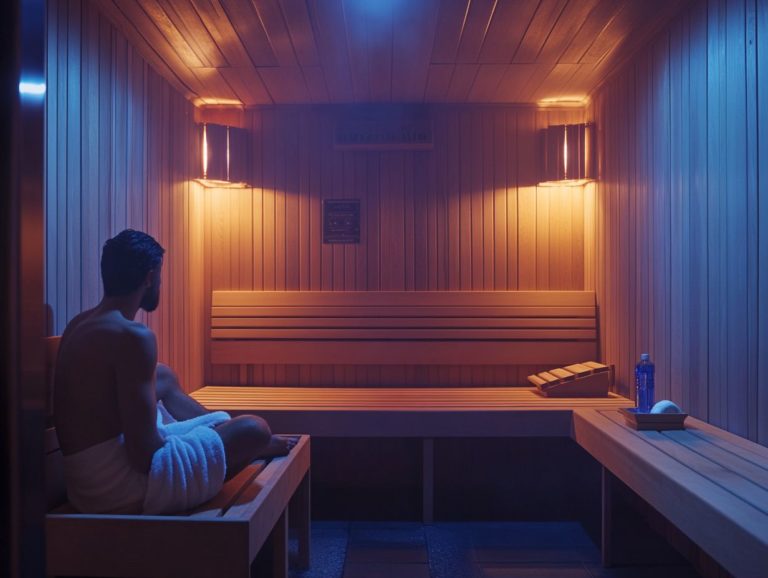How to Foster Sauna Safety Awareness
Saunas provide a luxurious retreat, but grasping the nuances of sauna safety is vital for ensuring an enjoyable sauna experience.
This article delves into the essence of a sauna, outlining the potential risks and the essential precautions necessary for safe sauna usage. It also highlights how to safeguard those around you, including children and pets, and emphasizes the importance of proper etiquette in shared environments.
You will also learn to identify the signs of overheating and the appropriate responses to take. Embrace the myriad benefits of sauna use and sauna therapy while prioritizing your safety and the well-being of others!
Contents
- Key Takeaways:
- Understanding Sauna Safety
- Precautions for Sauna Use
- Ensuring Sauna Safety for Others
- Recognizing Signs of Overheating and Heatstroke
- Frequently Asked Questions
- What is the purpose of fostering sauna safety awareness?
- How often should sauna safety awareness be promoted?
- What are some key safety tips to keep in mind when using a sauna?
- Can children use saunas safely?
- What should I do if I start feeling unwell while in the sauna?
- Are there any medical conditions that may make using a sauna unsafe?
Key Takeaways:

- Always be aware of the potential dangers and risks associated with using a sauna.
- Take precautions before, during, and after using a sauna session to ensure your safety and the safety of others.
- Be mindful of proper etiquette while supervising children and pets in a shared sauna space.
Understanding Sauna Safety
Understanding sauna safety is paramount for you, whether you’re a novice or a seasoned aficionado on your sauna journey. It ensures that your sauna experience is not only enjoyable but also allows you to get the most health benefits that come with regular use.
A sauna, be it traditional or infrared, provides a distinct avenue for relaxation, detoxification, and improved blood circulation in a sweat-inducing environment. However, it’s crucial to be aware of the potential dangers and health risks that can stem from improper usage or insufficient precautions. For guidance on safe practices, refer to sauna safety tips.
By familiarizing yourself with essential tips for a safe sauna session, you can enhance your wellness routine while effectively minimizing any sauna health risks.
What is a Sauna and How Does It Work?
A sauna is your personal oasis, designed to envelop you in either dry or wet heat sessions that can dramatically elevate your relaxation and well-being. You can explore various types of saunas, including traditional saunas, infrared saunas, Finnish sauna, and Turkish-style steam rooms, each presenting its own unique benefits and experiences.
For instance, traditional saunas, typically crafted from cedar or hemlock, deliver a high-temperature, low-humidity environment. This intense heat penetrates your skin, promoting detoxification and enhancing blood circulation for muscle relaxation.
Alternatively, if you prefer a milder experience, infrared saunas might be your ideal choice. They utilize infrared heaters that emit radiant heat directly absorbed by your body, allowing you to enjoy the warmth without the sweltering ambient temperature.
Steam rooms, with their moist heat generated by steaming water, offer exceptional benefits for respiratory health and skin hydration. Each type allows for distinct temperature control options, ensuring a personalized experience whether you re seeking a soothing unwind after a workout or a social gathering with friends, all while indulging in the myriad health benefits these saunas provide.
Potential Dangers and Risks
While saunas provide a wealth of health benefits, it s crucial to be aware of the potential dangers and risks involved to ensure a safe experience. Overheating, dehydration, and ignoring your body s signals can lead to serious health consequences, including heat exhaustion (when your body overheats) or heatstroke.
To truly relish the therapeutic effects of this heated environment, prioritize hydration before, during, and after your sauna sessions, paying close attention to your body signals. For more information on sauna safety, listening to your body is key; if you feel dizzy, exit the sauna right away to stay safe.
If you have pre-existing health conditions such as cardiovascular issues or respiratory concerns, especially when using high heat, it’s wise to consult a healthcare professional ahead of time to better understand your limits. Incorporating regular breaks and adhering to recommended time limits are essential precautions for sauna safety, allowing you to enjoy all the benefits without compromising your health.
Precautions for Sauna Use
Taking the right precautions for sauna use is essential for ensuring a safe and enjoyable sauna experience. Whether you re gearing up for your inaugural sauna session or you re a seasoned enthusiast, grasping the fundamentals of what to do before, during, and after your time in the sauna can greatly mitigate health risks and elevate your overall enjoyment.
Before Entering the Sauna

Before you step into the sauna, it’s essential to prepare yourself for a safe and enjoyable experience. This means you should hydrate well and wear comfortable clothes.
Hydration is your secret weapon for maximizing the benefits of the heat while keeping dehydration at bay. Drinking water or electrolytes minerals that help maintain your body’s balance beforehand can elevate your overall experience.
Choosing comfortable attire, like clothes that help keep sweat away from your body or even a simple towel, will help regulate your body temperature and allow for ease of movement.
Don’t overlook the sauna setup. Adjust the temperature to a soothing level, ensure good ventilation, and consider adding delightful aromas from essential oils in your sauna kit. To maximize your experience, it’s important to learn how to safely use an infrared sauna. This creates an inviting atmosphere, turning the sauna into your personal sanctuary for enhanced relaxation and rejuvenation.
During Sauna Session
During your sauna session, it’s essential to pay close attention to temperature control and your body’s signals to ensure a safe and enjoyable experience. Striking the right balance allows you to unwind while remaining attuned to how your body reacts to the sauna’s high heat.
Monitoring the temperature is crucial, as it influences how your body reacts to this unique environment. Aim for a range that feels both comfortable and effective, typically between 150 to 195 degrees Fahrenheit.
Be vigilant for signs of discomfort, such as excessive sweating, dizziness, or an unusually rapid heartbeat. Recognizing these signals can help prevent overheating, ensuring you savor every moment of rejuvenation.
It’s wise to take breaks and cool down if you begin to feel overwhelmed. This simple practice promotes a healthier sauna experience overall.
After Sauna Session
Post-sauna care is vital to maximize your health benefits and minimize risks. After your sauna session, focus on hydration and proper cooling down techniques to enhance your overall wellness routine.
Taking the time to cool down allows your body to gradually return to its normal temperature, which helps your blood flow better and prevents any sudden shocks to your system. Equally important is prioritizing hydration after your sauna experience; sweating can lead to significant fluid loss. Rehydrating with water or electrolyte-rich beverages replenishes essential minerals, supporting optimal recovery and maintaining your energy levels. For more insights on this, consider exploring the psychology of sauna safety and relaxation.
Incorporating practices like gentle stretching and enjoying a light, nutritious snack can further elevate your post-sauna experience. Additionally, it’s important to consider sauna safety gear, ensuring you feel refreshed and invigorated for the day ahead.
Ensuring Sauna Safety for Others
Ensuring sauna safety for others, especially children and pets, is essential when enjoying sessions in shared spaces. By understanding proper etiquette and providing vigilant supervision, you can cultivate a safe and enjoyable atmosphere for everyone involved.
Supervising Children and Pets
When supervising children and pets in a sauna, vigilance is paramount to ensure their safety in such a heat-intensive environment. Given the high temperatures and associated health risks, mastering effective supervision is crucial in preventing accidents and health issues.
Be mindful that young children and pets are particularly sensitive to extreme heat, making it crucial to establish strict guidelines for their sauna use. Before granting them access, consider the sauna’s temperature settings and limit their exposure time. For more detailed information, refer to sauna safety: the importance of flexibility. Keep a close eye on their hydration levels, as both children and pets can become dehydrated rapidly in this environment.
As a supervising adult, stay within arm’s reach and be attuned to any signs of distress, such as excessive panting or dizziness, and ensure proper hydration to protect against heat exhaustion. By implementing these precautions and understanding sauna use after workouts, you can create a safer experience while fully enjoying the relaxing benefits of a sauna.

Practicing proper etiquette in shared sauna spaces is vital for cultivating a respectful and enjoyable environment for everyone involved in your sauna session. By being mindful of your personal comfort and noise levels, you can significantly enhance the overall sauna experience.
Don t forget! These communal areas are frequented by diverse groups, each with their own customs and sauna traditions. Keeping conversations quiet and avoiding the use of mobile devices is essential. Excessive noise can disrupt the tranquility that many seek.
Hygiene is equally important. Use a towel while sitting and shower before entering to protect everyone’s health. Respecting personal space contributes to a more inviting atmosphere, allowing everyone to unwind comfortably.
By adhering to these guidelines, you can help foster a harmonious environment that truly elevates the sauna experience for all.
Recognizing Signs of Overheating and Heatstroke
Recognizing the signs of overheating and heatstroke is essential for your safety during sauna sessions. These conditions can present serious health risks if left unaddressed.
By understanding your body’s signals, you can fully enjoy the benefits of using the sauna for relaxation while effectively minimizing any potential dangers.
Symptoms and How to Respond
Symptoms of overheating and heatstroke can manifest as dizziness, nausea, and excessive sweating. It’s crucial to recognize how to respond effectively to ensure your safety. Quickly identifying these signs can significantly reduce risks and enhance the health benefits of your sauna session.
You might also notice a rapid heartbeat, headache, or confusion, which could escalate into more serious complications if not addressed promptly. Should you experience these symptoms, exit the sauna immediately and cool down by relocating to a shaded or air-conditioned space. For more insights on staying safe, consider reading about sauna safety and communication. Hydration is key; sipping on cool water or sports drinks will help replenish lost fluids and electrolytes.
Applying a damp cloth to your forehead or taking a refreshing cool shower can also assist in lowering your body temperature. Being attentive to these indicators and responding appropriately allows you to enjoy the relaxing experience while safeguarding your health.
Frequently Asked Questions
What is the purpose of fostering sauna safety awareness?
The purpose of fostering sauna safety awareness is to educate individuals on how to safely use a sauna, reduce the risk of accidents and injuries, and promote a safer sauna experience for all users.
How often should sauna safety awareness be promoted?

Sauna safety awareness should be promoted regularly, especially in public saunas or gyms where there may be a high turnover of users. It is also important to refresh safety guidelines periodically to ensure they are top-of-mind for all users.
What are some key safety tips to keep in mind when using a sauna?
Some key safety tips to remember when using a sauna include:
- Staying hydrated
- Not staying in the sauna for too long
- Avoiding alcohol and drugs before using the sauna
- Listening to your body for any signs of discomfort or dizziness
Can children use saunas safely?
Children should only use saunas under adult supervision and for a maximum of 5-10 minutes at a lower temperature. Keep a close eye on their time to ensure their safety and monitor their hydration before and after using the sauna.
What should I do if I start feeling unwell while in the sauna?
If you start feeling unwell while in the sauna, stop using it immediately and step out to cool down. Drink some water and take a break outside of the sauna before deciding if it is safe to continue using it.
Are there any medical conditions that may make using a sauna unsafe?
Yes, there are some medical conditions that may make using a sauna unsafe, such as heart conditions, low or high blood pressure, and pregnancy. It is important to consult with a doctor before using a sauna if you have any underlying health conditions.






